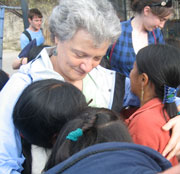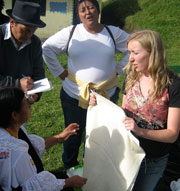Sustainability abroad
Director takes greenhouse knowledge to Ecuador
August 16, 2011
By Diane Hageman

A golden opportunity came forward this summer for Judy Purman, director of sustainability at the College of Saint Benedict, to put her greenhouse production background to use. She traveled with 13 other people from College of Saint Benedict and Saint John's University to Yambiro, Ecuador, located on the outskirts of Otavalo, a community of 250 families of indigenous people.
Traveling abroad is not new to Purman. She went to Amman, Jordan, as a Fulbright Scholar, the Dominican Republic as Peace Corps volunteer and spent time in England, Israel and Egypt as well.
This is the second summer a group of students, faculty and staff spent three weeks in Yambiro, where they collaborated with community leaders to identify and work on community needs and priorities identified by the community at large. In addition to Purman, there were eight College of Saint Benedict students, three Saint John's University students, and two faculty members; Patricia Bolaños, associate professor of Hispanic Studies and Gender Studies and Lu Ann Reif, associate professor of nursing.
Determining priorities
Last year, the community requested assistance with the development and construction of a greenhouse. Bolaños, the veteran of the group with three trips under her belt, approached Purman this past spring about participating in the trip.
"Patricia is very good about recognizing and supporting the needs this community identifies; she finds the expertise needed to support a project," Purman said. "Building a greenhouse encompasses the three tenants of sustainability - environment, economics and social justice. The people of Yambiro see this project as the means to improve their living conditions for themselves and their children, as well as generate income and provide job training."
Planning for a greenhouse
Much of Purman's time was spent helping the villagers plan the greenhouse production process when another CSB and SJU group travels back in 2012 to help build it. "I know the steps it takes to get the project going and how to plan those steps. And from my past overseas experience, I am aware of the cultural sensitivities. My role is to support and facilitate, it is the community's project so I am careful not to take over," Purman said.
In order for the village members to build a greenhouse, they, of course, need running water. Some parts of the village have it; the portion where they want to build the greenhouse does not. There is a stream one to two miles up the mountain where the water will come from.
Purman helped the community leaders find an engineer who will conduct a study this fall to determine the best way to bring the water down the mountain. "He agreed to do the study for free if the community agreed to hire him to oversee the installation next summer. The labor for the installation will be provided by the community itself," she explained.
While Purman concentrated on the greenhouse initiative, there were several other projects the CSB and SJU group worked on, including teaching English, sports, art and health to children; the Fair Trade Partnership with the Yambiro Women's Cooperative and the McNeely Center for Entrepreneurship (see sidebar); and repair of public bathrooms in the village.
Practicing Benedictine values and building trust
For Purman, it was about putting sustainability and Benedictine values into practice. "This is an amazing opportunity to demonstrate our values and involve our students first-hand. They benefited from the experience as much as the community did.
"When you're building a relationship with a community, it can take years to build the trust. Each year we return to Yambiro and help them to help themselves, our bond is strengthened," she said.
During the upcoming academic year, Purman and interns in her office will develop a plan for the pipeline and determine what will grow and sell best in the high altitude region of Ecuador.
She looks forward to next year when they can implement the water pipeline plan, present the findings on what will grow best in their region and actually build the greenhouse. "There are lots of opportunities to serve."

